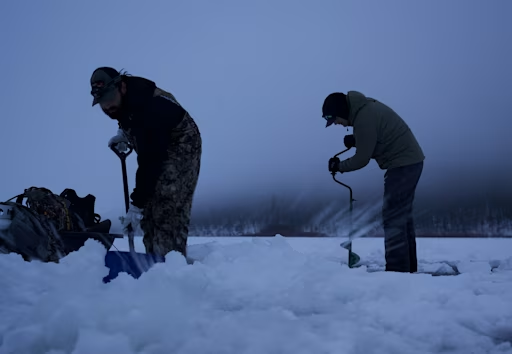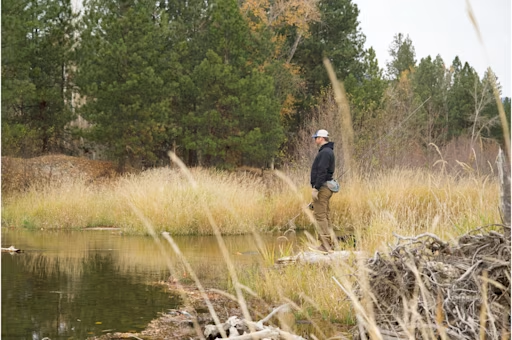How to start fly fishing: an intro to life on the fly
Fly fishing may seem complicated, but picking up the sport is easier than ever. This guide will take you through the gear and steps to start fly fishing today.
Share this article

Fly fishing can seem like an intimidating endeavor. The sport often brings to mind large complicated loops of line that would scare off anyone who has trouble with backlashes from a baitcaster.
The entry barriers to fly fishing are not that complicated, however.There is a learning curve when it comes to fly fishing, like casting and presentation, but these aren’t barriers as much as they are learning opportunities. Gear and tutorials are easier to find than ever and cheaper than you would think.
Below we are going to cover every step and every piece of gear you need if you’re interested in dipping your toe into the waters of fly fishing.
The Gear
Because fly fishing is a completely different type of fishing, none of your spinning gear will carry over, not even line. Rods, reels, lines, leader and flies are all unique to this style of fishing, but are also very affordable for beginners.
The rod

Unless you’re handlining, you can’t go fishing without a fishing rod. Fly rods are unique as their strength is measured in weights that go from 2 (the smallest and lightest) up to 12+ (suited for saltwater billfish)
Your fly rod weight will be dependent on where you live in the country and what species are available to you. If you only fish small streams in North Carolina for trout, for example, you are going to look for a 4 or 5 weight rod. If you only target bass in inland Florida, you will look for something stronger like a 6 or 7 weight. Pike anglers in the Great Lakes regions may look into getting up to an 8 weight even. The higher weight your fly rod is, however, the more difficult it may be to cast.
Most beginners should look into a 5 weight, which can handle most trout fishing and most bass fishing, two of the most popular freshwater species across the country.
After you’ve decided on a rod weight, you need to look into the action. The action on your rod references how flexible the rod is. Slow action rods have a lot of flex, making them more whippy, while fast action rods have little flex and medium action is often a nice mixture of both.
Slow action
Flexes from the base to the tip
Generally made from bamboo and fiberglass
Very forgiving of mistakes
Great for short casts on small water
Best for beginners targeting panfish and trout
Medium action
Good for short and medium distance casts
Can handle larger fish like small and largemouth bass
Made with graphite, or fiberglass
Bend starts towards the middle of the rod, up to the tip
Great for intermediate anglers looking to cast farther and in more adverse weather conditions, like wind.
Fast action
Made from graphite
Flex generally begins toward the tip of the rod
Very strong for dealing with powerful fish, like steelhead, salmon, bonefish etc
Very unforgiving to cast. Technique needs to be solid.
Essential for casting through the wind while saltwater fishing
Recommended for advanced anglers.
The reel

A beginner’s reel needs to be simple and not high end. High end reels feature robust drag systems for fighting large, generally saltwater, fish. Beginner fly anglers are generally not targeting these fish and whatever drag your reel has will be more than enough
The two main types of reels are cast and machined reels. Cast reels are cheaper, but heavier. They are made from metal and plastics melted down and poured into a mold. They are cheaper for a reason, but are fine when just starting out.
Machined reels are built with tools that precisely carve the reel out of metal. They look like a precision piece of equipment and function much smoother than cast reels. Either reel will suffice for a beginner, however.
Most reels you buy will have an enclosed drag brake drag system. The fully enclosed system is great for keeping debris out of the brake and keeping it functional. You may also find click and pawl reels which use a ratchet type of braking system. THis is fine for smaller fish, but cannot hold up to larger fighting species.
Tip: There are great rod and reel combos for beginners at great prices, leaving out a lot of the guesswork when it comes to finding a reel to match your rod.
The Line

Fly line is what propels your fly. Unlike spin, or cast fishing, which propels your line via split shot, or weighted lures at the end of your line, weighted fly line propels your weightless fly out instead.
Spin/cast fishing: your line follows your bait when casting
Fly fishing: your fly follows your line when casting
Your fly line will have a number weight to it that matches the weight of your fly rod.
There are also three types of fly line: floating, sink tip and full sink. Read more about the types of fly line.
Beginners should focus on floating line to start. This line, as it says, will float on the water’s surface and is the most versatile type. Floating line is useful for dry fly and nymphing for trout as well as streamer fishing for bass and panfish. You can always fish deeper into the water column if you need to by tying on a longer leader and tippet.
You will also need a roll of line called backing, which attaches your fly line to your reel. Some reels and fly lines come with backing so make sure to check before purchasing backing. Backing spools usually come in 12 to 30 pound breaking strength and in lengths of 50 to 1,000 yards. The amount of backing you need is directly related to the size of fish you are fishing for. Fifty yards will be plenty for small trout and panfish, while for saltwater species you may want up to 200 yards.
Leader/tippet
This is the line that runs from your fly line, to your fly. Leader comes in different weights and tippet is an even smaller line that helps you taper down for finesse casting. YOu can either buy multiple sizes of leader and tippet and build your own leaders, or you can buy readily made tapered leaders.
Note: If you do buy the premade leaders you will slowly lose the fine end as you tie and clip off different flies. Eventually you will either have to replace the entire tapered leader, or add on some tippet to keep a small tapered end.
Fly choice

Your fly choice is completely based on where you live and what you’re fishing for.
Flies come in different patterns and sizes, mimicking different insects, insect development stages and baitfish. If you live in bass and crappie country, you want several types of streamers that imitate baitfish, crawfish and shrimp. Trout anglers will need several types of nymphs, dry flies that imitate the stages of different types of mayflies, stoneflies and caddisflies. Trout anglers may want a small assortment of streamers as well.
To get the best selection of flies, make sure to visit a local fly shop. There is no substitute for the knowledge of a local shop and they will have every kind of fly that works on your local waters.
For those without a local fly shop, check out online retailers of flies, like the Fishbrain Shop to order your flies directly to your house.
Learning resources
Learning to fly fish is easier than ever as online guides are more readily available. Check for video tutorials from Orvis and Mad River Outfitters that thoroughly teach you how to cast, tie knots, present flies and more.
Don't forget to check out Huge Fly Fisherman either for weekly video tutorials, guides to fishing for salt and freshwater species and breakdowns of fishing culture.
After checking the tutorials, make sure to practice your skills. Cast in a park, or yard daily to get your technique down and set up hula hoops and buckets to perfect your accuracy.
Essential knots

Your improved clinch knot to attach your hook to your line is one thing that will carry over to fly fishing.
You also need to tie several knots to to attach your backing to your reel, your fly line to your backing and your leader to your fly line. Here is a handy guide for tying all the different knots for this process. You don't need to memorize these knots, however. You only need to know the surgeon’s knot, to attach the tippet to the leader, and the clinch knot, to attach your fly, to effectively fish in the field.
Use Fishbrain to find your water
Your last step is to find some water and and go fishing. The Fishbrain map can be your best friend in this case. Make sure and find bodies of water near you by opening the map and looking at catches. Study which fish are being caught in each body of water, to help you prepare for which flies to bring and even study other angler’s gear choices.
Fly fishing does not have to be an intimidating new skill to pick up. The barriers preventing you from learning this new skill are no different than learning any fishing skill and more affordable than ever. It doesn't matter how anyone fishes, as long as we all appreciate the water and our time on it. Learning new fishing skills, however, does help understand the sport we all love and the fish we love to chase.
Now let’s go fishing. We’ll bring the fly box.
If you haven't experienced the #1 fishing app worldwide, make sure and check out Fishbrain to see all the fish data, fishing spots, weather conditions you've been missing out on plus much more.

Download the Fishbrain app and access the best fishing spots in your area
Related blog posts
Master the hardwater season with advanced ice fishing tips . Learn how to find fish faster, refine your search and adjust presentations to catch more fish all winter long.

Your guide to Victoria’s best fish to catch in rivers, lakes, and coastal waters. Learn prime species, fishing tips, and key regulations

Learn how fish adapt as water temperatures cool from autumn to winter, including changes in behavior, metabolism, and habitat that help them survive.




